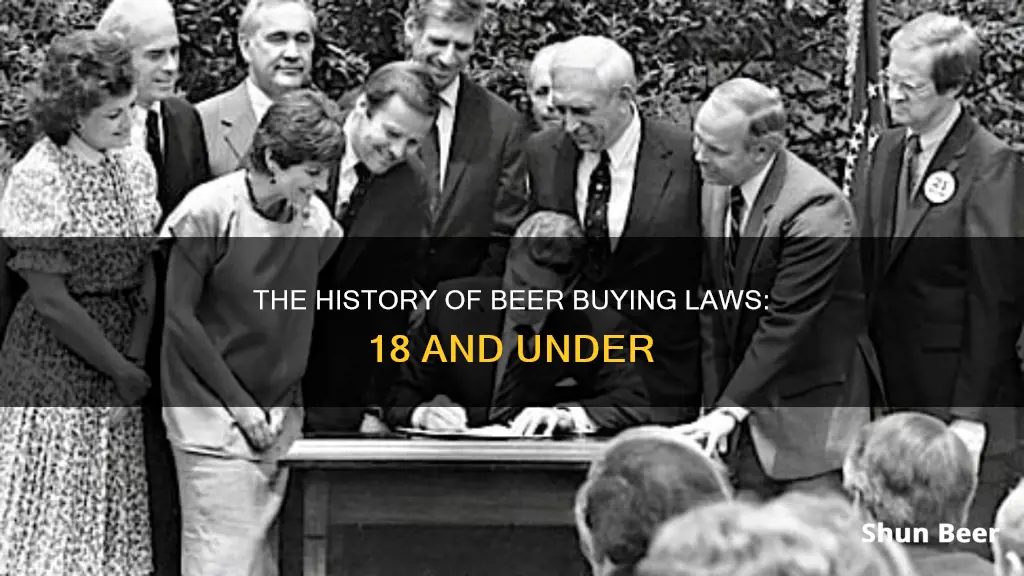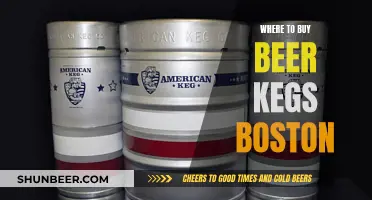
In the United States, the legal drinking age has changed several times over the years. In the 1970s, the legal drinking age varied by state, with some states setting the minimum age at 18 and others at 21. Between 1969 and 1976, around 30 states lowered their drinking age to 18, largely due to the passing of the 26th Amendment in 1971, which lowered the voting age from 21 to 18. This meant that 18-year-olds in most states could legally purchase and consume alcohol.
| Characteristics | Values |
|---|---|
| Year that buying beer was made 18 | 1970s |
| Reason for the change | The passing of the 26th Amendment in 1971, which lowered the voting age from 21 to 18 |
| Number of states that lowered their drinking age | 30 |
| Year the drinking age was raised to 21 | 1984 |
What You'll Learn

The drinking age in the US was lowered to 18 in the 1970s
In the 1970s, the legal drinking age in the United States was lowered to 18 in most states. This change was the result of a series of events that took place between 1969 and 1976, when around 30 states reduced their minimum purchase age, primarily due to the passing of the 26th Amendment in 1971. The 26th Amendment lowered the voting age from 21 to 18, and many states chose to lower their drinking age to match. This meant that 18-year-olds in most states could legally purchase and consume alcohol.
Before the 1970s, the drinking age had been more varied across the US. In colonial times, there were generally no age restrictions, and young teenagers commonly consumed alcohol, even in taverns. After the American Revolution, societal attitudes shifted due to the growing influence of the temperance movement and increasing awareness of the dangers of alcohol. As a result, drinking age laws became more common, and after the repeal of Prohibition in 1933, most states set the drinking age at 21, which was the voting age at the time.
However, in the late 1960s and early 1970s, societal attitudes towards drinking ages began to shift once again. The lowering of the voting age in 1971 was a significant factor, as it established a new standard for the age of majority. As a result, many states started to lower their drinking age to align with the new voting age, and by 1972 or 1973, most of these changes had taken place. This situation remained in place for several years and it became common to see 18-year-olds drinking in bars and buying alcohol in liquor stores.
However, this era of relaxed drinking laws was relatively short-lived. From 1976 onwards, several states began to raise their drinking ages again, primarily to address concerns related to drunk driving fatalities. Then, in 1984, the National Minimum Drinking Age Act was passed, requiring all states to raise their drinking age to 21 by 1986 or risk losing a portion of their federal highway funding. By 1988, all 50 states had a minimum drinking age of 21, ending the period during the 1970s when most states allowed 18-year-olds to legally purchase and consume alcohol.
Where to Buy Yuengling Beer: State Availability Guide
You may want to see also

The 26th Amendment lowered the voting age from 21 to 18 in 1971
In the United States, the minimum age for buying alcohol has changed over time. In colonial America, there were no age restrictions, and young teenagers commonly consumed alcohol, even in taverns. After the American Revolution, societal attitudes towards alcohol consumption shifted due to the growing influence of the temperance movement and increasing medical understanding of its dangers.
Following the repeal of Prohibition in 1933, most states set the minimum drinking age at 21, as this was the voting age at the time. However, in the late 1960s and early 1970s, societal attitudes towards drinking ages began to shift again. The passing of the 26th Amendment in 1971, which lowered the voting age from 21 to 18, was a significant factor in this change. As a result, many states started to lower their minimum drinking age to match the new voting age, with most of these changes taking place in 1972 or 1973. This meant that 18-year-olds in most states could legally purchase and consume alcohol.
From 1969 to 1976, around 30 states lowered their drinking age to 18, largely due to the passing of the 26th Amendment. During this time, it was common for people under the age of 18 to consume alcohol, and many individuals report that it was easy to purchase alcohol underage in the 1970s. In certain states, individuals as young as 14 or 15 were able to purchase and consume alcohol without much difficulty. However, it is important to note that the ease of accessing alcohol for minors varied depending on the state and local enforcement of drinking laws.
In most states, 18-year-olds could buy beer with a maximum alcohol content of 3.2%. Wisconsin, for example, lowered its drinking age from 21 to 18 in 1973. However, this era of relaxed drinking laws was short-lived. From 1976 onwards, several states began to raise their drinking ages again, in an attempt to combat drunk driving fatalities.
The National Minimum Drinking Age Act, enacted in 1984, ended the period of varied drinking ages across the US. This Act raised the legal drinking age to 21 and was signed into law by President Ronald Reagan. It required all states to set their minimum purchasing age to 21 and prohibited persons under 21 from purchasing or publicly possessing alcoholic beverages. By 1988, all 50 states, two permanently inhabited territories, and Washington, D.C., had raised their drinking age to 21.
While the minimum drinking age has been standardised across the United States since the 1980s, the debate around it continues. The current age limit of 21 is a point of contention for many Americans, as it is higher than the age of majority (18 in most states) and exceeds the drinking age in most other countries. Some states have proposed legislation to lower the drinking age, while others, like Guam, have recently raised their drinking age to 21.
The Best Places to Buy Duvel Beer in Belgium
You may want to see also

The drinking age varied pre-Prohibition
In the US, the drinking age varied pre-Prohibition. In colonial America, there were generally no age restrictions, and alcohol consumption by young teenagers was common, even in taverns. Following the American Revolution, however, this freedom was gradually reduced due to the growing temperance movement and increasing medical understanding of the dangers of alcohol. By 1881, the drinking age was set at 21, with no exceptions for parental consent.
In 1919, Prohibition was enacted, and it remained in place until 1933. In the years following the repeal of Prohibition, nearly all states set the minimum drinking age at 21, as this was the voting age at the time.
In the 1970s, the drinking age was lowered in many states. Between 1970 and 1975, 29 states lowered the minimum drinking age to 18, 19, or 20. This change was largely in response to the lowering of the voting age from 21 to 18 in 1971. However, this change was short-lived, and by 1988, all 50 states had returned the drinking age to 21.
Ciderboys Beer: Where to Buy and Enjoy It
You may want to see also

The National Minimum Drinking Age Act raised the drinking age to 21 in 1984
In the United States, the minimum legal drinking age (MLDA) is currently 21 years. This was established by the National Minimum Drinking Age Act of 1984, which was signed into law by President Ronald Reagan on July 17, 1984.
Prior to the Act, the minimum drinking age varied across states. While most states initially set their minimum drinking age at 21 after the repeal of Prohibition in 1933, this began to change in the 1970s. From 1969 to 1976, about 30 states lowered their drinking age, usually to 18, following the passage of the 26th Amendment in 1971, which lowered the voting age from 21 to 18.
The National Minimum Drinking Age Act of 1984 required states to raise their minimum age for the purchase and public possession of alcohol to 21. States that did not comply with the Act would have 10% of their federal highway funds withheld. This was later lowered to 8% from the fiscal year 2012 onwards. The Act did not criminalize alcohol consumption by those under 21, and many states still allow "underage" consumption in certain circumstances, such as with the consent and supervision of family members.
The Act was written by Senator Frank Lautenberg and was influenced by Mothers Against Drunk Driving (MADD). It was upheld as constitutional by the United States Supreme Court in 1987 in South Dakota v. Dole. By 1995, all 50 states, two permanently inhabited territories, and Washington, D.C., were in compliance with the Act, although Puerto Rico, Guam, and the Virgin Islands have maintained a minimum drinking age of 18 despite losing a portion of their federal highway funding.
The National Minimum Drinking Age Act has been successful in reducing motor vehicle crashes and underage drinking. From 1985 to 1991, the percentage of young people aged 18 to 20 who reported drinking alcohol in the past month decreased from 59% to 40%. Additionally, young adults aged 21 to 25 who reported drinking during the same period dropped from 70% to 56%.
German Beer Glasses: Where to Buy Them?
You may want to see also

The drinking age in Wisconsin was lowered to 18 in 1973
In the early 1970s, the drinking age in Wisconsin was lowered from 21 to 18. This change allowed 18 to 20-year-olds to purchase and consume alcohol, marking a significant shift in the state's alcohol regulations. However, it's important to note that this lowered drinking age was short-lived.
The history of alcohol regulation in Wisconsin is complex and deeply rooted in the state's cultural and political landscape. Settlers from the eastern United States, known as "Yankees," often clashed with German immigrants over alcohol consumption, particularly on Sundays, and the prevalence of alcoholism. This tension led to various laws being passed, including the Graham Law in 1872, which prohibited drunkenness and the sale of alcohol to minors. German-Americans strongly opposed this law, and their efforts resulted in the election of a more lenient legislature in 1874, which passed laws that reduced restrictions on alcohol sales.
By the early 1970s, the drinking age in Wisconsin had been lowered to 18, reflecting a more relaxed attitude towards alcohol consumption among young adults. However, this change was short-lived. In 1983, the Wisconsin Act 74 was passed, raising the drinking age to 19, and just a year later, in 1984, the drinking age was raised again to 21, bringing the state into compliance with the National Minimum Drinking Age Act. This change ensured uniformity across the state, and by September 1, 1988, Wisconsin had a consistent drinking age of 21.
While the drinking age in Wisconsin has been standardized at 21 for several decades, there are certain exceptions to this rule. For instance, those under 21 can consume alcohol if they are accompanied by a parent, legal guardian, or spouse who is of legal drinking age. Additionally, 18 to 20-year-olds can possess (but not consume) alcohol as part of their employment. These exceptions provide some flexibility to the drinking age restrictions in the state.
Kansas Memorial Day: Beer Buying Explained
You may want to see also
Frequently asked questions
From 1969 to 1976, around 30 states lowered their drinking age to 18.
The change was largely due to the passing of the 26th Amendment in 1971, which lowered the voting age from 21 to 18. Many states chose to lower their drinking age to match.
No, it varied by state. For example, in Wisconsin, the drinking age was 21 until 1972, when it was lowered to 18.







